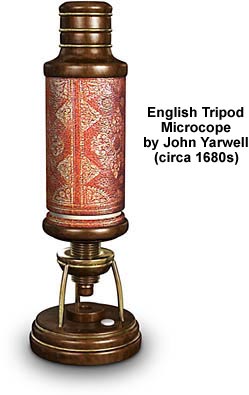John Yarwell English Tripod Microscope
English tripod microscope design motifs dominated the late seventeenth century and were sold by shopkeepers throughout London. The model featured below was built by John Yarwell around 1680 and has been redrawn from photographs of the original microscope, which is featured in Gerard Turner's excellent book Collecting Microscopes, a volume in Christie's International Collectors Series of books on antiques.

In order to focus the microscope, the body tube must be screwed into and out of the wooden collar, which is supported by a tripod attached to a turned wooden base. The microscope has three lenses: a small objective lens in the snout at the front of the nosepiece, an internal field lens at the top of the inner tube, and an eye lens housed in a wooden ocular. During storage, the ocular is protected by a wooden container, which is designed to hold additional eye lenses. Materials used to construct the microscope are lignum vitae, which bestows the deep rich wooden texture; pasteboard, which is used to construct the inner and outer body tubes; and the gold-tooled leather that decorates the outer surface of both body tubes. To observe a specimen in transmitted light, it is firmly affixed over the circular hole in the wooden stage and the microscope is then held up to a light source (the sun or a lamp) while the specimen is viewed through the ocular.
BACK TO SIXTEENTH-SEVENTEENTH CENTURY MICROSCOPES
